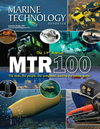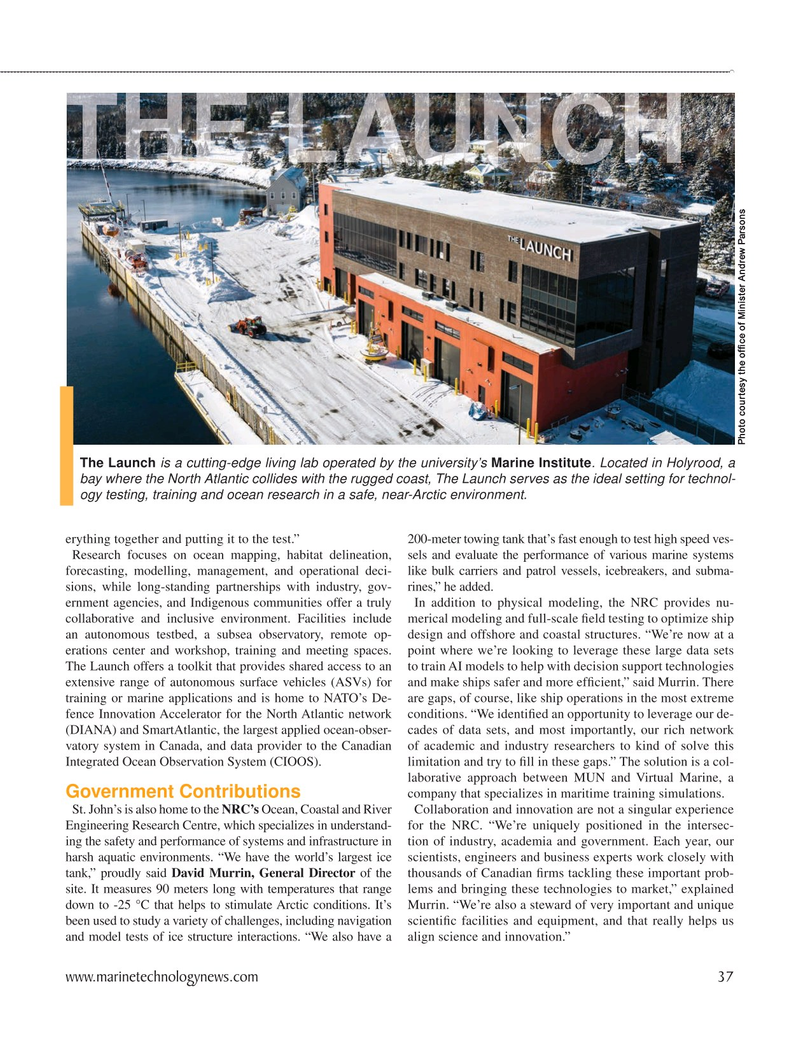
Page 37: of Marine Technology Magazine (September 2024)
Read this page in Pdf, Flash or Html5 edition of September 2024 Marine Technology Magazine
THE LAUNCH
Photo courtesy the of? ce of Minister Andrew Parsons
The Launch is a cutting-edge living lab operated by the university’s Marine Institute. Located in Holyrood, a bay where the North Atlantic collides with the rugged coast, The Launch serves as the ideal setting for technol- ogy testing, training and ocean research in a safe, near-Arctic environment. erything together and putting it to the test.” 200-meter towing tank that’s fast enough to test high speed ves-
Research focuses on ocean mapping, habitat delineation, sels and evaluate the performance of various marine systems forecasting, modelling, management, and operational deci- like bulk carriers and patrol vessels, icebreakers, and subma- sions, while long-standing partnerships with industry, gov- rines,” he added.
ernment agencies, and Indigenous communities offer a truly In addition to physical modeling, the NRC provides nu- collaborative and inclusive environment. Facilities include merical modeling and full-scale ? eld testing to optimize ship an autonomous testbed, a subsea observatory, remote op- design and offshore and coastal structures. “We’re now at a erations center and workshop, training and meeting spaces. point where we’re looking to leverage these large data sets
The Launch offers a toolkit that provides shared access to an to train AI models to help with decision support technologies extensive range of autonomous surface vehicles (ASVs) for and make ships safer and more ef? cient,” said Murrin. There training or marine applications and is home to NATO’s De- are gaps, of course, like ship operations in the most extreme fence Innovation Accelerator for the North Atlantic network conditions. “We identi? ed an opportunity to leverage our de- (DIANA) and SmartAtlantic, the largest applied ocean-obser- cades of data sets, and most importantly, our rich network vatory system in Canada, and data provider to the Canadian of academic and industry researchers to kind of solve this
Integrated Ocean Observation System (CIOOS). limitation and try to ? ll in these gaps.” The solution is a col- laborative approach between MUN and Virtual Marine, a company that specializes in maritime training simulations.
Government Contributions
St. John’s is also home to the NRC’s Ocean, Coastal and River Collaboration and innovation are not a singular experience
Engineering Research Centre, which specializes in understand- for the NRC. “We’re uniquely positioned in the intersec- ing the safety and performance of systems and infrastructure in tion of industry, academia and government. Each year, our harsh aquatic environments. “We have the world’s largest ice scientists, engineers and business experts work closely with tank,” proudly said David Murrin, General Director of the thousands of Canadian ? rms tackling these important prob- site. It measures 90 meters long with temperatures that range lems and bringing these technologies to market,” explained down to -25 °C that helps to stimulate Arctic conditions. It’s Murrin. “We’re also a steward of very important and unique been used to study a variety of challenges, including navigation scienti? c facilities and equipment, and that really helps us and model tests of ice structure interactions. “We also have a align science and innovation.” www.marinetechnologynews.com 37
MTR #7 (34-49).indd 37 10/3/2024 12:14:30 PM

 36
36

 38
38
